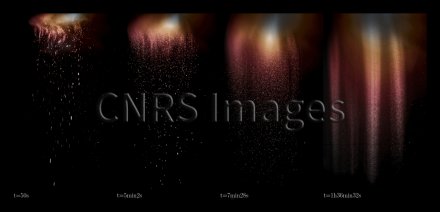Production year
2022

© Quentin KRIAA / Benjamin FAVIER / Michaël LE BARS / IRPHE / CNRS Images
20220122_0007
How is it that small rocky planets such as Mercury or Ganymede, one of Jupiter’s moons, have a magnetic field? It could be due to to “snow” made up of flakes of iron. In the interior of these planets, the flakes, falling from the outer reaches of the liquid core to its centre, could cause turbulence that might potentially generate a magnetic field. To investigate this process, the researchers modelled iron snow in a tank of stratified salt water using glass beads – as fine as flour – to which they added an orange dye. Initially, a few large flakes fall out of the cloud at high speed. But, as time goes by, billions of small ones slowly fall in continuous streams. The sinking of the dye reflects the
impact of snow flakes on their environment. This image is one of the winners of the 2022 La preuve par l’image (LPPI) photography competition.
The use of media visible on the CNRS Images Platform can be granted on request. Any reproduction or representation is forbidden without prior authorization from CNRS Images (except for resources under Creative Commons license).
No modification of an image may be made without the prior consent of CNRS Images.
No use of an image for advertising purposes or distribution to a third party may be made without the prior agreement of CNRS Images.
For more information, please consult our general conditions
2022
Our work is guided by the way scientists question the world around them and we translate their research into images to help people to understand the world better and to awaken their curiosity and wonderment.